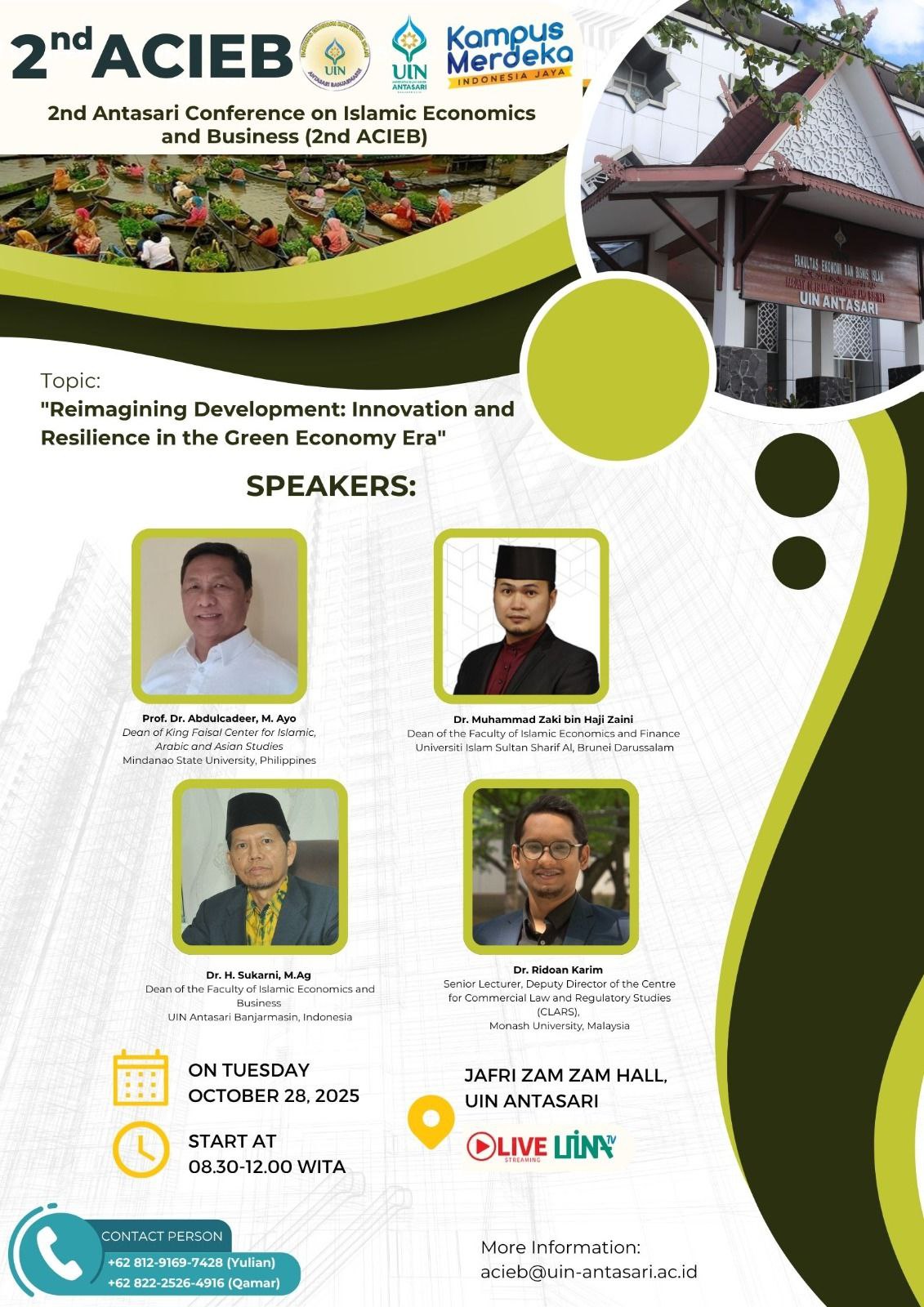Public Preference for Islamic Savings as an Instrument Choice in Financial Planning in Banjarmasin City
Keywords:
Community Preferences, Sharia Savings, Financial PlanningAbstract
Public preference for sharia-based financial products continues to increase along with increasing awareness of Islamic economic principles. This study aims to analyze the factors influencing Banjarmasin City residents' preferences in choosing sharia savings as the primary instrument in their financial planning. The method used is a quantitative approach with factor analysis techniques. The research sample consisted of 100 respondents selected using a non-probability sampling method with a purposive sampling technique. Data were collected through questionnaires and analyzed using SPSS. The variables studied included sharia understanding, consumer attitudes, religiosity, social factors, culture, price, and psychological factors. The results showed that the majority of Banjarmasin City residents have a positive preference for sharia savings. The dominant factors influencing this preference are sharia understanding and religiosity with a percentage of variance of 55.801%. Other factors that also influence this preference are social, cultural, and price factors (5.128%), psychological and personal factors (3.697%), and personal and religious factors (3.252%). The total variance explained by these four factors reached 67.878%. This research provides important insights for Islamic financial institutions to improve public literacy and understanding of Islamic savings as a sharia-compliant financial planning instrument.References
Ajzen, I. (2012). The Theory of Planned Behavior. Handbook of Theories of Social Psychology: Volume 1. https://doi.org/10.4135/9781446249215.N22
Ali, M. (2020). Kajian Fatwa Dewan Syari’ah Nasional Majelis Ulama Indonesia Nomor: 02/DSN-MUI/IV/2000 Terhadap Penerapan Akad Wadi’ah Yad Dhamanah dalam Program SI-MANTAB. An-Nawazil: Jurnal Hukum Dan Syariah Kontemporer, 2(02), 17–31. https://doi.org/10.69784/annawazil.v2i02.17
Arifin, Y., Rizky, G., Adhicandra, I., Riadi, H. F., & Siswanto, A. (2024). Manajemen Sumber Daya Manusia: Dasar-Dasar MSDM. PT. Sonpedia Publishing Indonesia.
Asnawi, H. F., Maulida, A. Z., & Qamaruddin, M. (2023). Analisis Preferensi Masyarakat Kalimantan Selatan Pada Bank Syariah Pasca Merger 3 Bank Umum Syariah (BUS). Jurnal Ilmiah Ekonomi Islam, 9(1), Article 1. https://doi.org/10.29040/jiei.v9i1.6886
Dakhi, R. A. (2022). METODE PENELITIAN SOSIAL Pedoman Praktis Penulisan Skripsi, Tesis dan Disertasi. Cipta Media Nusantara.
Fadli, V. P. (2021). Perhitungan Akad Mudharabah Muthlaqah Dan Akad Wadi’ah Yad Dhamanah Dalam Tabungan iB Hijrah Pada PT. Bank Muamalat Indonesia KC Panyabungan. Nahdatul Iqtishadiyah: Jurnal Perbankan Syariah, 1(2), 94–111.
Fathurrahman, A., & Azizah, U. (2018). Analisis Faktor-Faktor Preferensi Mahasiswa terhadap Perbankan Syariah. Ihtifaz: Journal of Islamic Economics, Finance, and Banking, 1(2), Article 2. https://doi.org/10.12928/ijiefb.v1i1.273
Hestiningrum, S. E. A. D. (2023). Analisis keuangan keluarga lansia pensiun. Journal of Economic, Business & Accounting Research, 1(1). https://www.journal-iasssf.com/index.php/JEMBAR/article/view/261
KBBI, V. (2023). Hasil Pencarian—KBBI VI Daring. https://kbbi.kemdikbud.go.id/entri/preferensi?spm=a2ty_o01.29997173.0.0.1eca5171J05Hm4
LPP KALSEL. (t.t.). Diambil 18 November 2025, dari https://www.bi.go.id/id/publikasi/laporan/lpp/Documents/Laporan-Perekonomian-Provinsi-Kalimantan-Selatan-November-2023.pdf?utm_source=chatgpt.com
Novriwanda, R., & Herman, S. (2024). DETERMINAN PREFERENSI KONSUMEN DALAM MEMILIH RUMAH SAKIT SYARIAH. Imanensi: Jurnal Ekonomi, Manajemen, Dan Akuntansi Islam, 9(1), 37–46.
Nurrohmah, R. F., & Purbayati, R. (2020). Pengaruh Tingkat Literasi Keuangan Syariah dan Kepercayaan Masyarakat terhadap Minat Menabung di Bank Syariah. Jurnal MAPS (Manajemen Perbankan Syariah).
OJK, S. J. K. P. K. S. (2025). Siaran Pers KOJK Kalimantan Selatan: Sektor Jasa Keuangan Provinsi Kalimantan Selatan Terjaga Stabil Untuk Mendukung Perluasan Akses Keuangan Daerah. https://www.ojk.go.id/id/berita-dan-kegiatan/publikasi/Pages/Siaran-Pers-KOJK-Provinsi-Kalimantan-Selatan-Terjaga-Stabil-Untuk-Mendukung-Perluasan-Akses-Keuangan-Daerah.aspx?utm_source=chatgpt.com
Puspharini, L. A., & Hidayati, C. (2016). Perencanaan keuangan keluarga melalui optimalisasi komposisi investasi pada Tabungan, Asuransi dan Reksadana berdasar prioritas tujuan. Jurnal Ekonomi Akuntansi, 1(1), 51–66.
Rasyid, S., Hidayatullah, M. S., & Alfiannor, I. (2025). Akad Wadiah Yad Dhamanah Pada Perbankan Syariah Menurut Muhammad Syafi’i Antonio Dan Ammi Nur Baits. Indonesian Journal of Islamic Jurisprudence, Economic and Legal Theory, 3(2), 1069–1098. https://doi.org/10.62976/ijijel.v3i2.1084
Statistik Perbankan Syariah, OJK, S. P. S. (2023). Statistik Perbankan Syariah. https://ojk.go.id/id/kanal/syariah/data-dan-statistik/statistik-perbankan-syariah/Documents/Forms/AllItems.aspx?RootFolder=%2fid%2fkanal%2fsyariah%2fdata%2ddan%2dstatistik%2fstatistik%2dperbankan%2dsyariah%2fDocuments%2fPages%2fStatistik%2dPerbankan%2dSyariah%2d%2d%2dJuni%2d2023&FolderCTID=0x012000F543BA4D809ACF459D0A6B2EEAB024F4
Sugiyono, P. (2019). Metode Penelitian Kuantitatif, Kualitatif.
Summerfield, C., & Tsetsos, K. (2015). Do humans make good decisions? Trends in Cognitive Sciences, 19(1), 27–34. https://doi.org/10.1016/j.tics.2014.11.005
Surahman, S., Sihabudin, S., & Fauji, R. (2024). Analisis Komparatif Tingkat Literasi Keuangan dan Prilaku Pengelolaan Keuangan pada Nasabah Bank Emok dan Bank BRI Unit Tanjung Jaya di Desa Sukaratu Kec.Cilebar Kab. Karawang. https://journal.ipm2kpe.or.id/index.php/BUDGETING/article/view/7780/5890
Susanti, A., & Ardyan, E. (2017). Tingkat pendidikan, literasi keuangan, dan perencanaan keuangan terhadap perilaku keuangan UMKM di Surakarta. Telaah Bisnis, 18(1). http://journal.stimykpn.ac.id/index.php/tb/article/view/93
Wu, X., Sun, K., Zhu, F., Zhao, R., & Li, H. (2023). Human Preference Score: Better Aligning Text-to-image Models with Human Preference. 2023 IEEE/CVF International Conference on Computer Vision (ICCV), 2096–2105. https://doi.org/10.1109/ICCV51070.2023.00200

